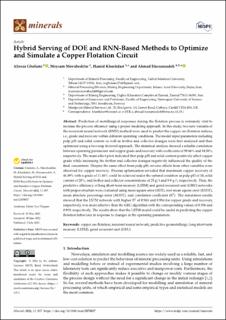| dc.description.abstract | Prediction of metallurgical responses during the flotation process is extremely vital to increase the process efficiency using a proper modeling approach. In this study, two new variants of the recurrent neural network (RNN) method were used to predict the copper ore flotation indices, i.e., grade and recovery within different operating conditions. The model input parameters including pulp pH and solid content as well as frother and collector dosages were first analysed and then optimized using a two-step factorial approach. The statistical analysis showed a reliable correlation between operating parameters and copper grade and recovery with coefficients of 99.86% and 94.50%, respectively. The main effect plots indicated that pulp pH and solid content positively affect copper grade while increasing the frother and collector dosages negatively influenced the quality of the final concentrate. Despite the same effect from pulp pH, reverse effects from other variables were observed for copper recovery. Process optimization revealed that maximum copper recovery of 44.39% with a grade of 11.48% could be achieved under the optimal condition as pulp pH of 10, solid content of 20%, and frother and collector concentrations of 25 g/t and 9.9 g/t, respectively. Then, the predictive efficiency of long short-term memory (LSTM) and gated recurrent unit (GRU) networks with proper structure were evaluated using mean square error (MSE), root mean square error (RMSE), mean absolute percentage error (MAPE), and correlation coefficient (R2). The simulation results showed that the LSTM network with higher R2 of 0.963 and 0.934 for copper grade and recovery, respectively, was more effective than the GRU algorithm with the corresponding values of 0.956 and 0.919, respectively. The results show that the LSTM model could be useful in predicting the copper flotation behaviour in response to changes in the operating parameters. | en_US |

